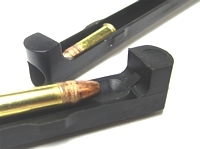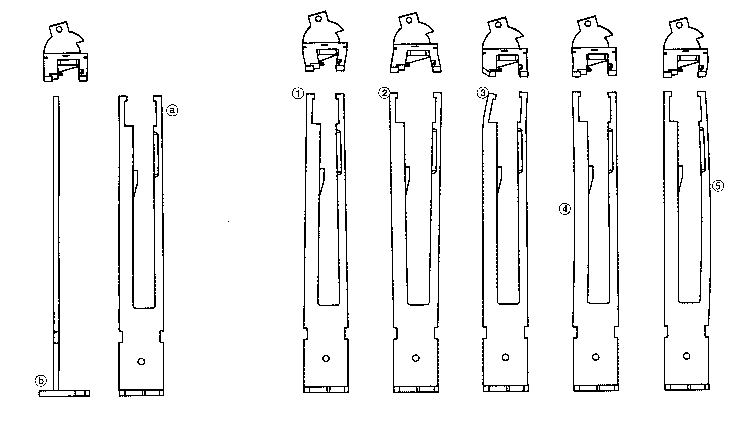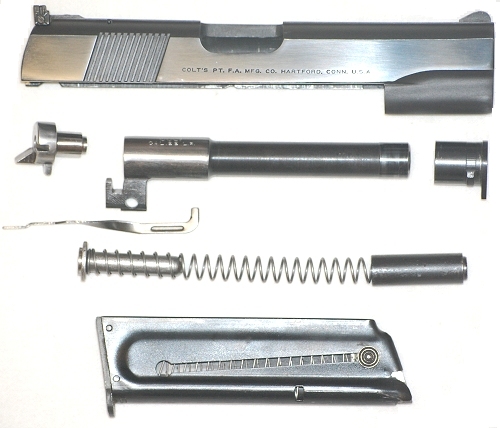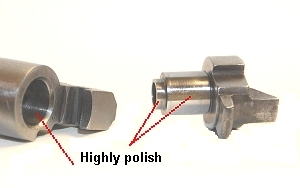 |
.22 RF conversion units allow the use of relatively inexpensive .22 RF ammunition in a center fire arm for practice and familiarization and I think everyone should have them. More than a few people claim that they are unreliable, but they really aren't. These conversion units have their quirks which need to be addressed in order to get maximum reliability.
While conversions are available for a wide variety of firearms this page will focus on those for the AR series of rifles and the 1911 pistol. The tips and techniques given here are applicable to other conversion units.
AR Conversion Units
 |
These are all pretty much based on the same design--a reciprocating blow-back bolt that runs on a guide rail assembly with a .22RF chamber in an adapter that fits in the .223/5.56 chamber.
Firearms designer Maxwell Atchisson is generally credited with the development of the first marketable AR-15 conversion unit while he was on the staff of the old Military Armament Corp (MAC) during the early 1970s. The original MAC units were available in two versions; One allowing full auto fire while the other provided semiauto only. Each unit used a special 16 round box magazine which was the same size and shape as a standard AR-15 twenty round magazine but later a 30 round banana type magazine was developed and this design was later copied by J.A. Ciener for use in his conversion. The MAC conversion itself was little more than a replacement bolt assembly which contained .22LR chamber, recoil spring, extractor and ejector which allowed for straight blowback operation. The entire device was enclosed in a metal sleeve and was inserted as a direct replacement for the standard .223 bolt carrier. The Colt unit was basically the Atchisson unit with the enclosing sleeve removed.The rights to the Atchisson conversion were later obtained by J.A. Ciener who began marketing a new an improved conversion under his own name and it is on this design that the modern units are based on, with the removal of the metal sleeve. This allows for much easier access to the internals for cleaning,.
The problem with this chamber adapter approach is that the AR's bore is oversized for rim fire projectiles (.224" vs. .222"), the twist rate in not optimum (1:7 to 1:12 vs. 1:16), and there is the possibility of fouling the gas tube with lead shavings.
Most units greatly benefit from a good deburring and polishing of the U-shaped carrier frame and corresponding slots in the bolt. (The stainless steel units are usually smoother from the box than the parkerized ones.) In addition, I have found that polishing the inside of the chamber adapter--the chamber adapter's "chamber" and bore--with some bore paste on a patch with a jag helps to prevent fouling buildup and improves extraction and ease of cleaning. Many of the chamber adapters I have seen have been rather rough inside. Also, ensure that the rear part of the bolt that contacts the hammer is smooth and free from sharp edges and that the extractor nose is polished.
For best reliability the conversion units need to be kept clean and well lubricated. Every conversion unit I have seen, but one, which had a bad extractor, ran fine when cleaned and lubed. Standard AR lubricants like TW-25B oil (MC2500) and SLIP EWL work very well. When cleaning the drop-in units be sure to clean out the chamber adapter. A new bore brush spun in a drill makes short work of any fouling and after cleaning the bolt blow out the firing pin channel and add a drop of lubricant. Also ensure that there is no carbon buildup under the extractor and put a drop of lubricant on the extractor pivot.After using the in-barrel conversion units always inspect the AR's gas tube for fouling before returning to centerfire use. While most people do not report a problem it is easy for the gas tube to become badly fouled with carbon and lead shavings just as blank ammo heavily fouls the tubes. Usually the gas tubes will blow clear after a couple of rounds of full pressure ball ammo, (requiring a cleaning of the action before proceeding). Note, that the military does not allow the combat issue of rifles used for training with blank ammo unless the gas tubes have been replaced. The non-optimum barrel and fouling potential are good reasons for a dedicated .22 RF upper.
Conversion units can be fussy about the ammo used. High velocity, plated bullet ammo generally works more reliably than standard velocity or plain lead bullet ammo. You may have to try several brands and bullet weights to find the one your unit likes best, and then stock up.
Failure to extract is generally caused by carbon buildup under the extractor and on the bolt face, a damaged extractor tip, or a weak extractor spring. Clean the area under the extractor claw as crud can build up there and prevent proper extractor fit on the case rim. Make sure the hook on the extractor is square and sharp so it can grip the case rim. TACOM makes an improved extractor for the Ceiner/CMMG style conversions that gives more reliable extraction (Brownells #100011416).
 |
|
TACOM Extractor |
Most failures to feed are caused by carbon buildup on bolt carrier frame which prevents proper bolt travel or by a damaged magazine.
Failures to fire are generally caused by carbon build up on the bolt face, chamber face, or rails that prevent the the .22 bolt from fully seating, or by a dirty firing pin channel.
Many conversion units seem to prefer the rounded front hammers as opposed to the common notched front type. If you are experiencing random reliability issues and polishing the bottom rear edge and bottom of the bolt doesn't help you may want to try swapping the hammer.
 |
 |
| Notched | Rounded |
CMMG makes a modified charging handle in which the interior of the "U" shape handle is partially file in to prevent loaded rounds from getting trapped in there. Costs about $20. You can modify a standard charging handle by filling in about 2" of the space starting at the front end (including the hole in the end) with JB Weld and radiusing the filler using a 3/8" dowel before the JB Weld sets up. Just degrease the charging handle before filling and put some tape on the sides to keep the epoxy off. Trim the filler inside the slot before it sets, with a sharp knife.
 |
|
CMMG's anti-jam charging handle (bottom) |
If the conversion unit has been disassembled and the unit doesn't function properly upon reassembly check to see if the guide rails have become misaligned. The rails must be flat and free from any bending or warping. For proper functioning the frame should be straight with a VERY SLIGHT taper towards the front should be evident (see "a" below), and the rails must be perpendicular to the base plate. (see "b" below). The space between the notch should take a .705" gage and not take a .715" gage. (These are the specs for the CMMG unit, but in my experience apply to most other units of the same design.)
 |
|
Properly
aligned
1) Rails bent too far in 2) Rails bent too far apart 3) Bent frame ends 4) Rail bowed inward 5) Rail bowed outward |
Drawing courtesy CMMG
1911 Conversion Units
The original 1911 conversion unit from Colt utilized a floating chamber design that helped to mimic the recoil of a .45 round. Modern 1911 conversions and other handgun conversions are of the straight blowback design utilizing either a full or partial slide made of aluminum which makes production less expensive, at the cost of a completely different feel upon firing. (The Colt floating chamber unit has a steel slide.) While a properly set up floating chamber design can be quite accurate, the expense of manufacturing led to its being discontinued.
 |
 |
| Original Colt "Ace" floating chamber conversion | Typical current blowback unit |
Handgun conversions behave pretty much identically to the AR units and respond to the same "tuning" and tricks.
For best reliability the conversion units need to be kept clean and well lubricated. The current blowback units use fairly light springs so keeping the units clean and lubricated is important.. Carefully inspected for rough edges and burrs on the feed ramps, chamber mouths, the hammer face, bolt face, and slide raceways, and ejector, and polish these areas. With these areas attended to the conversions are generally quite reliable. Polishing of the radius of the slide's firing pin stop helps to reduce friction. Standard lubricants like TW-25B oil (MC2500) and SLIP EWL work very well. Avoid thick greases.Conversion units can be fussy about the ammo used. High velocity, plated bullet ammo generally works more reliably than standard velocity ammo. You may have to try several brands to find the one your unit likes best, and then stock up.
Failure to extract is generally caused by carbon buildup under the extractor and on the bolt face or a dirty chamber, a damaged extractor tip, or a weak extractor spring. Clean the area under the extractor claw as crud can build up there and prevent proper extractor fit on the case rim.
Most failures to feed are caused by the wrong ammo, problems with the magazines, or sharp edges on the chamber mouth.Failures to fire are generally caused by carbon build up on the bolt face or chamber face that prevents the slide from fully seating. Ensure you keep these areas clean as most conversion will fire slightly out of battery resulting in split cases.
With the Colt floating chamber units the most important tuning is to highly polish the inside of the breach of the barrel where the floating chamber insert goes and also the respective areas of the floating chamber. This polishing will not only improve functioning but will also make cleaning easier. Also polish the tip of the extractor. Because the floating chamber increased recoil these unit generally work well with a variety of loads but definitely need to be used with plated bullets. Polishing the feed ramp and chamber on the floating insert helps to ensure smooth feeding, and polishing the nose of the extractor-- insuring that the hook is clean and sharp, and occasionally tweaking the the floating ejector by careful bending all help to ensure proper extraction and ejection. Fitted with a "match" bushing they are just as accurate as a duty 1911. I wish I could find one at a realistic price.
 |
|
Colt conversion polish points |
Conversion units for other types of pistols are all similar in construction and respond to the same treatments.
Colt Floating Chamber conversion unit courtesy John C.
Dedicated .22 RF Conversions
While being able to shoot rimfire ammunition in your "real" firearm is a great idea, I personally believe that a dedicated rim fire arm is superior for the stand point of keeping your actual firearm always ready to go.
With AR platforms this is easily accomplished by simply building a dedicated .22 RF upper that you can just mount on your lower receiver. There are several inexpensive upper receivers available and several manufacturers offer complete dedicated uppers or parts to build your own.
CMMG (http://cmmginc.secure-mall.com/item/Dedicated-.22-Barrel-and-adapter-1520) offers a dedicated rim fire barrel with the proper bore size and twist without a gas port, as well as various conversion bolt assemblies. They also offer complete dedicated uppers. http://cmmginc.secure-mall.com/category/Dedicated-.22LR-Uppers-184.
 |
|
CMMG dedicated M4 style
dedicated .22 RF barrel and adaptor. The piece below the barrel is
the conversion adapter |
If you use a red dot sight there are numerous inexpensive units that mimic Aimpoints quite closely in size and dot size that you can use to complete the setup. In addition several rifle manufacturers now make complete .22RF clone of varying ergonomic compatibility with a real AR. The unit pictured below was built up on an inexpensive generic upper receiver using the CMMG barrel and the CMMG/Brownells conversion unit and some left over components. It is topped with an inexpensive 3 moa dot NcStar red dot sight that closely replicates the "feel" of the Aimpoint Comp 3 on the "real" receiver.
 |
With the 1911 pistol you can pick up a separate frame (the light weight ones work well) and use the conversion to build a dedicate .22RF pistol. Some manufacturers offer a purpose built .22 RF 1911 pistol. I once had a Colt floating chamber unit on an aluminum frame built to be identical in all respects to my primary 1911. Using 40 gr HV plated solid bullets the recoil was like a 185 gr target load in the .45 and it shot groups that were the same as the .45. I'm still kicking myself for selling it in a moment of weakness.
I am aware of conversions for the 1911, Glock, Beretta 92, SIG 220, 226, 229, and the Browning P-35. S&W makes a complete .22RF M&P pistol but that's really not a conversion kit. Owners of other brands of pistols are pretty much out of luck. I know of at least one Glock owner who after using an after market metal frame to customize his working Glock, built a .22 RF gun on the left over plastic frame.
Ceiner makes .22 conversion kits but they have had a long reputation for poor quality, non-existent customer service, and ripping customers off. They were recently (November, 2011) raided and the principal was indicted for fraud. While they are back in business (2012) I would avoid doing business with them.
Non-cartridge Trainers
There are also some very nice .177 pellet and BB gun trainers. Umarex (Umarex.com) makes a line of very nice CO2 BB pistols in the form of Berettas, 1911s, Browning P35, HK, M&P, Walther, as well as Colt and S&W revolvers, and a "M4" select fire BB rifle (their part number 2254855). Winchester also offers an "AR" BB/pellet rifle. Airsoft rifles and pistols can also provide training opportunities.
WANT LIST
I'd like to see reasonably priced rimfire conversions for the S&W M&Ps and Shields, Springfield XD, and the FNP, (If they exist, please let me know by clicking here.)
Please email comments or questions to Fr. Frog by clicking here.
| Return to Fr. Frog's Homepage
Disclaimer
As far as I know all the information presented above is correct and I have attempted to ensure that it is. However, I am not responsible for any errors, omissions, or damages resulting from the use or misuse of this information, nor for you doing something stupid with it. (Don't you hate these disclaimers? So do I, but there are people out there who refuse to be responsible for their own actions and who will sue anybody to make a buck.)
Updated
2022-04-22 @ 1325